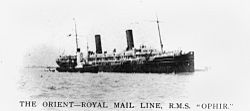Ophir (ship)
|
||||||||||||||||||||
|
||||||||||||||||||||
|
||||||||||||||||||||
|
||||||||||||||||||||
The Ophir was a passenger ship put into service in 1891 by the British shipping company Orient Steam Navigation Company , which was used in passenger and mail traffic from Great Britain to Australia .
history
The 6814 GRT steamship Ophir was built at the Robert Napier & Sons shipyard in Govan and was launched on April 11, 1891. She was the third ship of the Orient Steam Navigation Company and the second to be built from structural steel . The 141.73 meter long and 16.29 meter wide passenger and mail ship had two chimneys, two masts and two screws . The ship was powered by two sets of triple expansion steam engines that developed 9500 PSi and allowed a top speed of 18 knots.
The Ophir set a new standard in the design of the Orient Line ships. Instead of four masts and two chimneys close together, it had only two masts and the two chimneys were far apart. The most important lounges were in between. She was also the first large twin screw steamer that was built for the Australian postal service and the associated passage of the Suez Canal . In the end, it turned out to be not particularly economical , but was very popular with paying customers because of its luxurious furnishings.
In October 1891 the Ophir was completed and offered space for 220 passengers in 1st class and another 150 passengers in 2nd class. The Kaiser Wilhelm II , which had been used by Norddeutscher Lloyd (NDL) since 1889, was somewhat larger, but it offered fewer cabin spaces, was slower and was a single-screw ship. On November 6th, the Ophir began her maiden voyage from London via Suez and Colombo to Melbourne and Sydney . As the largest British ship on the line to Australia, she was surpassed in the following year by the Himalaya , 6,898 GRT, the Peninsular and Oriental Steam Navigation Company , which was followed in 1896 by the even larger China , 7,912 GRT, of this shipping company. At the same time, the NDL used the even larger Barbarossa class ships with over 10,000 GRT to Australia, which offered over 400 cabin spaces.
Use as a royal yacht
The Ophir became particularly famous for its use as a royal yacht for a world tour of the Duke and Duchess of York (later King George V and Queen Mary ) in 1901, for which she was converted and specially equipped. In March 1901 the Ophir left Portsmouth for the nearly eight-month voyage, during which a total of 17 destinations were visited and which took them to Australia, New Zealand, South Africa and Canada. The ship was accompanied by warships of the Royal Navy , including the HMS Niobe and her sister ship HMS Diadem , as well as the HMS Juno and the HMS St. George . As part of this tour, the Ophir also visited New Zealand , making it the shipping company's first ship to dock in this country.
Line service and military service
From 1902 to 1913 the Ophir was used again in regular service. She started her last voyage as a mail steamer on June 20, 1913 on the Australian route. In 1915 she was requested by the Admiralty for military service and used as an Armed Merchant Cruiser during the First World War . The ship was armed with eight 152 mm guns and initially served in the Azores, from January 1916 to March 1917 off West Africa with the 9th Cruiser Squadron, which at the end of 1916 also included the Swiftsure , the armored cruisers Donegal , Sutlej and King Alfred and the auxiliary cruiser Avenger , ex RMS Aotearoa (14766 ts, 8 × 152 mm guns), belonged and searched in vain for the German auxiliary cruiser Möve in the Central Atlantic. In April 1918, the Ophir is said to have been used in China. In 1918 the Admiralty bought the steamer and from then on used it as a hospital ship .
Final fate
In July 1919 the obsolete ship was laid up on the Clyde , sold for demolition in August 1921 and finally scrapped in Troon (Scotland) in 1922 .


